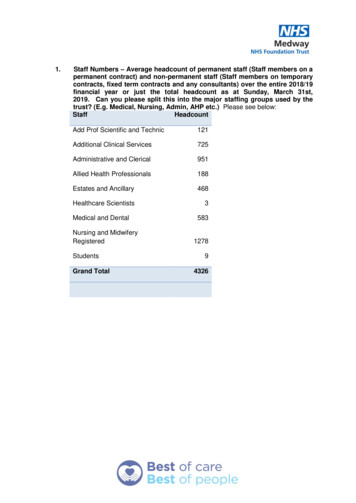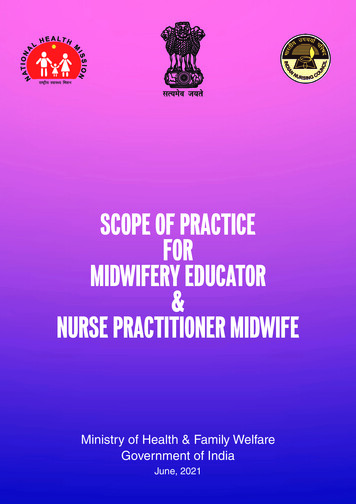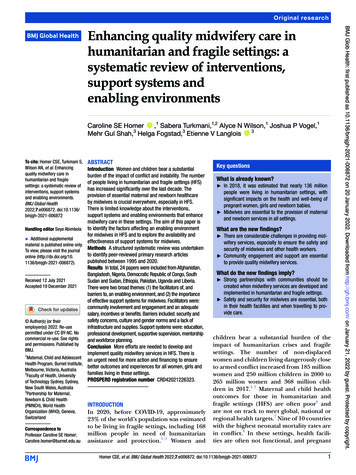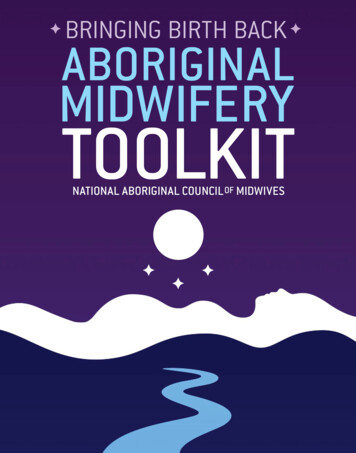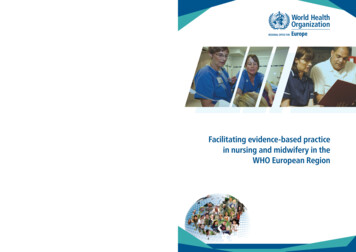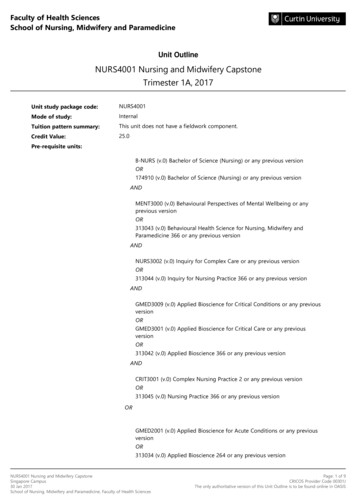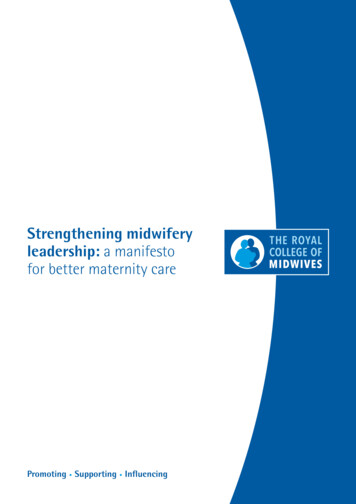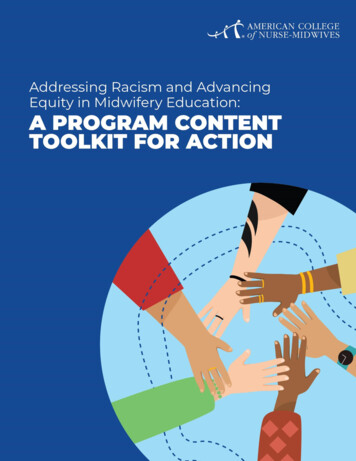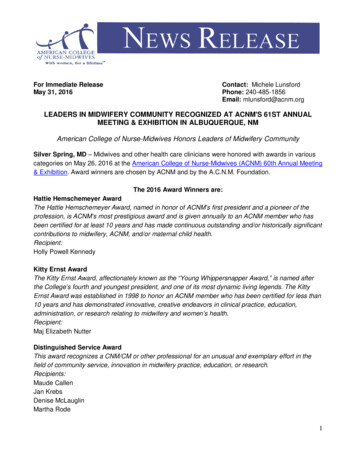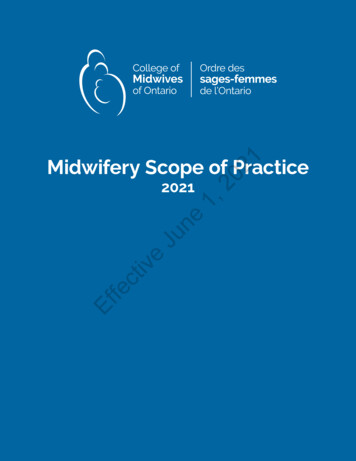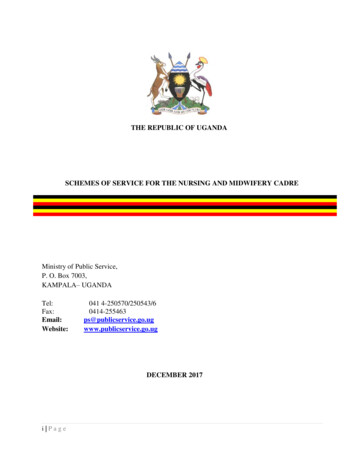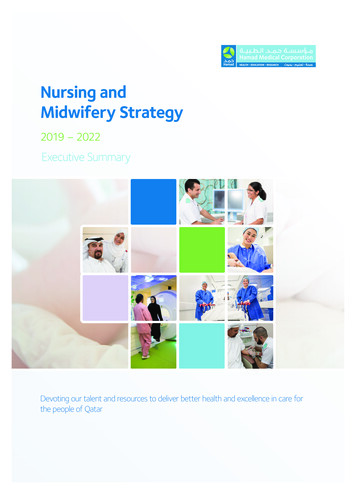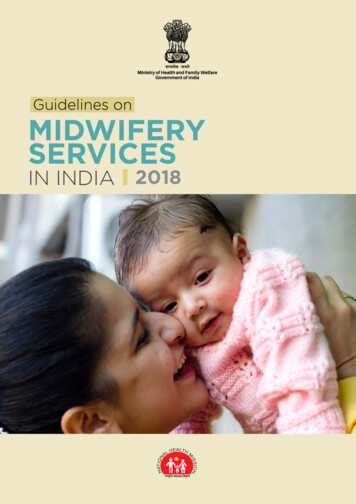
Transcription
Guidelines onMIDWIFERYSERVICESIN INDIA 2018GUIDELINES ON MIDWIFERY SERVICES IN INDIA1
2GUIDELINES ON MIDWIFERY SERVICES IN INDIA
Guidelines onMIDWIFERYSERVICESIN INDIA 2018GUIDELINES ON MIDWIFERY SERVICES IN INDIA3
4GUIDELINES ON MIDWIFERY SERVICES IN INDIA
6GUIDELINES ON MIDWIFERY SERVICES IN INDIA
8GUIDELINES ON MIDWIFERY SERVICES IN INDIA
10GUIDELINES ON MIDWIFERY SERVICES IN INDIA
12GUIDELINES ON MIDWIFERY SERVICES IN INDIA
14GUIDELINES ON MIDWIFERY SERVICES IN INDIA
16GUIDELINES ON MIDWIFERY SERVICES IN INDIA
ACRONYMSCACompetency AssessmentCAMTCentres for Advanced Midwifery TrainingsEmOCEmergency Obstetric CareFRUFirst Referral UnitGNMGeneral nursing and midwiferyICM:International Confederation of MidwivesICMRIndian Council of Medical ResearchINCIndian Nursing CouncilMDGMillennium Development GoalMEMidwifery educatorMMRMaternal Mortality RatioMoH&FWNHMMinistry of Health and Family WelfareNational Health MissionNHSRCNational Health Systems Resource CentreNIHFWNational Institute of Health and Family WelfareNMRNeonatal Mortality RateNMTFNational Midwifery Task ForceNMTINational Midwifery Training InstituteNPMNurse Practitioner in MidwiferyNPMUNational Programme Management UnitOSCEObjective Structured Clinical ExaminationRGIRegistrar General of IndiaRMRegistered MidwifeRMTIsRegional Midwifery Training InstitutesRNRegistered NurseSDGSustainable Development GoalSIDASwedish International Development AgencySNCState Nursing CouncilSNCUSpecial Newborn Care UnitsSOMISociety of Midwives, IndiaSRSSample Registration SystemTFRTotal Fertility RateTNAITrained Nurses Association India
CONTENTSCHAPTER 1:Introduction 1CHAPTER 2:Goals, Objectives and PrinciplesCHAPTER 3:Strategic Framework CHAPTER 4:13Selection of Candidates for Nurse Practitioner in Midwifery TrainingType of CandidatesCurriculum and Training DurationIntegration of Midwives into the Public Health SystemPosting of Nurse Practitioner in MidwiferyRange of Services to be provided by Nurse Practitioners in MidwiferyAdministration at the select healthcare facility for Midwifery-led HealthcarePreparing the Health Care Facility for Midwifery-led UnitBrandingFinancial Arrangement for Setting up Midwifery-led Care UnitsCareer Progression of Nurse Practitioner MidwivesRegulation and Certification of Nurse Practitioner MidwivesEducation and Training of Nurse Practitioners in Midwifery 921National Midwifery Training InstituteRegional Midwifery Training InstitutesBudgetary GuidanceCourse CurriculumCHAPTER 5:Institutional Arrangements 31CHAPTER 6:Monitoring, Evaluation & Quality Assurance Mechanism Key Monitoring ParametersEvaluation of Midwifery InitiativeQuality Assurance Framework33
22GUIDELINES ON MIDWIFERY SERVICES IN INDIA
CHAPTER – IIntroductionBackground and RationaleIndia has come a long way in improving maternal and newborn health. The Maternal Mortality Ratio (MMR) ofIndia has reduced from 301 maternal deaths per 100,000 live births in 2001–03 as per the Registrar General ofIndia, Sample Registration System (RGI, SRS) to 130 maternal deaths per 100 000 live births in 2014–16 (RGI,SRS). As a result, India has achieved the Millennium Development Goal (MDG) in reduction of maternal andnewborn mortality. This momentous achievement has been possible because of various interventions implementedunder the umbrella of the National Health Mission (NHM). The NHM has provided much needed impetus towardsreduction of maternal and newborn mortality. The total fertility rate (TFR) in India is 2.2 (National Family HealthSurvey- 4). At the same time, Indian public health system also experienced a rapid expansion of health caredelivery infrastructure and phenomenal growth in the number of institutional deliveries. Still, this impressiveincrease has not led to an expected commensurate decline in maternal and neonatal mortality.Nearly 32,000 pregnant women each year still lose their lives during pregnancy, childbirth and the postnatalperiod each year. In addition, 5,90,000 newborns die each year in the first month of life. The neonatal mortalityrate (NMR) in India is 24 per 1000 live births whereas the early neonatal mortality rate is 18 per 1000 live birthswhich is a serious cause of concern. Furthermore, there are disparities in distribution of these deaths based onsocio-demographic variables such as education, socio-economic class, caste as well as differential geographies.Additional efforts are needed in India to increase Universal Health Coverage and to achieve the SustainableDevelopment Goals (SDGs) for maternal, newborn and child health.One of the major contributors towards maternal deaths is poor quality of intrapartum care. As per the LancetNewborn’ series of 2014, the time around labour and childbirth accounts for almost 46% of maternal deathsand 40% of stillbirths and neonatal deaths occur. This suggests the need for improving quality of care duringintrapartum period in public and private healthcare institutions.Two major reasons for poor intrapartum care are either lack of trained service providers or over medicalization ofthe delivery process. Many pockets of populations within India face an acute shortage of trained human resources.The Rural Health Statistics of 2016 indicate that, against the requirement of 5,510 obstetricians at CommunityHealth Centres across the country, only 1,859 are in place (34%). This is a similar situation for the deployment ofpaediatricians. This is because of the skewed presence of specialists in urban areas. Aspirational districts in Indiaare further disadvantaged, with eight States having institutional delivery rate of less than 70%, and three Stateswith institutional delivery of less than 52%. This includes the State of Nagaland with an institutional delivery rateof 32%.GUIDELINES ON MIDWIFERY SERVICES IN INDIA1
Certain other areas of India, especially urban areas, are suffering from the over-medicalization of pregnancy andchildbirth. As per the World Health Organization (WHO) guidance 2015, “at a population level, C- Section rateshigher than 10% are not associated with reductions in maternal and newborn mortality rates”. However, theNational Family Health Survey (NFHS-4) reports that C-Section rates in India have increased from 8.2% in 2006to 17.2% in 2016. There are nine States in the country that currently have State C-Section rates of over 30%. TheState of Telangana has experienced an extreme shift to over-medicalisation with a 58% C-Section rate in publicfacilities and a 75% C-Section rate in private facilities. This situation highlights the undeniable need to have analternative model of delivery of care.Disrespect and abuse of women during child birth acts as a deterrent for the women and her family to opt forinstitutional delivery. The Government of India has stressed “Promoting Respectful Maternity Care and CognitiveDevelopment of Baby” under the LaQshya programme. However, respectful care is missing from the currentnursing and medical curriculum.Midwifery-led care can address these issues by promoting quality, continuity of care through provision ofwomen-centric care and promoting natural birth. This model of care is well supported by global evidence.Introduction to MidwiferyThe provision of midwifery is witnessing long awaited increase in global attention. Recognizing the significantcontribution made by midwives worldwide, many countries are giving centre stage to midwives in order to improvequality of care, reduce “over-medicalization” during child birth and increase efficient use of resources.What is midwifery ?“Skilled, knowledgeable and compassionate care for childbearing women, new-born infants and families across thecontinuum throughout pre-pregnancy, pregnancy, birth, postpartum and the early weeks of life. Core characteristicsinclude optimising normal biological, psychological, social and cultural processes of reproduction and early life;timely prevention and management of complications; consultation with and referral to other services; respect forwomen’s individual circumstances and views; and working in partnership with women to strengthen women’sown capabilities to care for themselves and their families.” (Lancet Series on Midwifery, 2014)Who is a midwife?“A midwife is a person who has successfully completed a midwifery education programme that is dulyrecognized in the country where it is located and that is based on the International Confederation of Midwives(ICM) Essential Competencies for Basic Midwifery Practice and the framework of the ICM Global Standards forMidwifery Education; who has acquired the requisite qualifications to be registered and/or legally licensed topractice midwifery and use the title ‘midwife’ and who demonstrates competency in the practice of midwifery.”(International Confederation of Midwives, 2015)Why does India need midwifery?Global evidence has shown that the introduction of midwifery care has historically translated into the increasedavailability of quality maternal and newborn health services, and significantly aided the reduction of maternal andnewborn mortality and morbidity.2GUIDELINES ON MIDWIFERY SERVICES IN INDIA
The State of the World’s Midwifery Report 2014,which examined the midwifery workforce data across73 low- and middle-income countries, calls for urgentinvestment in high-quality midwifery care. The 73countries represented in the report account for 96%of global maternal deaths, 91% of stillbirths and 93%of newborn deaths. However, these countries haveonly 42% of the world’s doctors, midwives and nurses.Of the 73 countries, only four have the workforceneeded to provide the care needed by women andtheir newborns.The WHO Statement on C-Section Rates (2015)describes that C-Section are effective in savingmaternal and infant lives, but only when they arerequired for medically indicated reasons. At populationlevel, C-Section rates higher than 10% are notassociated with reductions in maternal and newbornmortality rates. This means that approximately 85%of pregnancies and births do not require specializedobstetric intervention. The Lancet Series on Midwifery(2014) notes that 87% of services can be provided bymidwives, when educated to international standards.Midwifery care includes the entire continuum of carefor women as well as newborn care, breastfeeding,family planning and screening women for HIVinfection, tuberculosis and malaria. As midwivesare often the first point of contact for women withthe health system, early signs of non-communicablediseases can be detected through routine antenatalcheck-ups.Experience from Midwifery CareSWEDENSweden has a rich history of midwifery for over300 years. It is a vast country with a sparsepopulation making the availability of doctors torural populations difficult in the past. Systemicmidwifery programme was developed and scaledup in the entire country. Sweden’s national healthstrategy includes giving midwives and doctorscomplementary roles in maternity care and equalinvolvement in setting public health policy resultingrapid decline in MMR. Currently, Sweden has one ofthe lowest MMR in the world.SRI LANKADuring the 1950s, most births in Sri Lanka tookplace at home with the assistance of untrainedbirth attendants. By the end of the 1980s though,over 85% of all births were attended to by skilledpersonnel, mainly community-based midwives. Thenumber of trained midwives increased 20 fold fromyear 1941 to 2000. These midwives were backedby a good referral system and supportive healthpolicies. MMR of Sri Lanka declined from 600 in1950 to 30 in 2015.A Cochrane Review on “Midwife-led continuitymodels vs other models of care for childbearing women” (2016) provides evidence that midwife-led continuity ofcare can result in a 24% reduction in pre-term birth, a significant reduction in episiotomy, instrumental birth or useof pain relief while increasing psychological support for women.In summary “Midwifery is associated with improved efficient use of resources, and outcomes when providedby midwives who are educated, trained, licensed and regulated, and that midwives were most effective whenintegrated into the health system in the context of effective teamwork, referral mechanisms and sufficient resources.”(Lancet Series of Midwifery, 2014)Thus midwifery care introduces a system level shift from fragmented maternal and newborn care focused onidentification and treatment of pathology, to skilled and compassionate woman-centric care.GUIDELINES ON MIDWIFERY SERVICES IN INDIA3
History of Midwifery in IndiaSeveral attempts have been made to formally introduce midwives into India’s health system. A post basic course,known as the Nurse Practitioner in Midwifery (NPM) course, was instituted by the Indian Nursing Council (INC).In 2000-2003, with support from the ‘India – Australia Training and Capacity Building Project’, a curriculum forthe NPM was prepared, with the aim to provide nurses with advance knowledge, skills and attitudes which -allowthem to become safe and competent NPMs who can practice independently in rural areas. The duration of thecourse was 18 months (including 6 months internship) and was developed using the essential competencies setout by the ICM. The INC also developed midwifery practice and clinical standards. This initiative was pilot tested inthe State of West Bengal. Two batches of training were conducted and 12 candidates who passed out of this coursewere posted as NPMs and were offered a remuneration equivalent to that of Assistant Nursing Superintendent.The “Inter-Institutional Collaboration between Institutions in India and Sweden for Improving Midwifery andEmergency Obstetric Care (EmOC) Services in India” project 2007-13 was carried out by collaboration betweenState governments, the Indian Institute of Management – Ahmedabad (IIM-A), the Society of Midwives, India(SOMI), the Trained Nurses Association, India (TNAI), the Advanced Nursing Society (ANS), the White RibbonAlliance, India (WRAI) supported by the Swedish International Development Agency (SIDA), the Karolinska Institute,and the Swedish Midwifery Association. The objectives of the project were: capacity building to improve midwiferyskill; research and advocacy; pilot testing to develop a midwifery focused model of care; policy analysis, andnetworking. Five Centres for Advanced Midwifery Trainings (CAMT) were established in four States with advanceskills laboratories, training equipment, mannequins, audio-visual teaching aids and well-equipped libraries. Fifteensenior faculty members (9 in 1st batch and 6 in 2nd batch) teaching midwifery and maternal health relatedsubjects were nominated by the State governments and were given three months training, part of which wasin Sweden. In addition, the tutors were regularly mentored and given additional skill training on site. The projectwas successful in increasing visibility of midwifery care at policy level and was partially successful in bringingmidwifery to the focus of programme managers in the four States. Adequate mechanisms were not put in placefor sustainability and scaling-up for systemic integration into the health system.Recently, the INC re-introduced the Post Basic Diploma in Nurse Practitioner in Midwifery, a one year course inmidwifery post BSc nursing training. The course was adopted by the States of West Bengal and Gujarat. Examplesof past experiences and current on-going midwifery trainings from various States are indicated in Table 1.4GUIDELINES ON MIDWIFERY SERVICES IN INDIA
Table 1:Examples of Midwifery training courses in India from various StatesStateProjectCurrent situationWest Bengal(2002/ 2011)India-Australia Training and Capacity Building project”In 2002, the first course of 18 months training in NursePractitioner Midwifery started under the India–AusAIDproject, based on curriculum developed by INC. Twelve postsof NPM sanctioned by the State Government. Total twobatches of training conducted.In 2011, West Bengal implemented the One Year Post BasicDiploma in Nurse Practitioner in Midwifery.Training stopped aftertwo batches. Twelvecandidates posted inPHCs and BPHCs.Andhra Pradesh(AP), West Bengal(WB), Gujarat andTamil NaduBeginning with the NPM course in two States (West Bengal& Gujarat), five CAMT centres were established in fourStates with 12 month training course. Fifteen senior facultiesunderwent a three-month advanced tutor course, some ofwhich was in Sweden. In Gujarat, training of NPM for oneyear led to a separate cadre of NPM equal to Matron class 3.Midwifery visibilityincreased, howeverthe initiative was notscaled up.Telangana(2011/2014/2017)In 2011, the Professional Midwifery Education and TrainingProgramme were conducted by Fernandez Hospital.In 2014 Fernandez Hospital was accredited to initiate thePost basic Diploma in NPM with 10 seats.In 2017, the Government of Telangana initiated a tripartitepartnership between State Government, UNICEF andFernandez Hospital to train nursing students in midwiferyusing 18 months course based on ICM competencies.Training of first batch is going on. Training is supportedby NHM. Total 126 posts of midwives created by the StateGovernment.Training is going on.Madhya Pradesh(2016)Eighteen months training on Midwifery is going on for fournurses at private institute, Choitram Hospital, based on ICMcompetencies. No involvement of State Government.Training is going on.Key Learnings from the History of Midwifery in IndiaBefore introducing midwifery, it is critical to understand the reasons for partial success/ failure of the earlierattempts to establish midwifery programme in India. Based on the opinions of experts, it was that following factswhich affected the success of the midwifery cadre in India:ĶĶ Role Clarity of NPM and their Integration into the Existing Heath System: The ill defined roles ofmidwives, AMNs and staff nurses posed a challenge to integrate midwives as a separate cadre in thehealth system.ĶĶ Career Progression of NPMs: Similarly midwives were introduced into the health system, a careerprogression pathway was not adequately mapped out making it difficult for the newly introduced NPMsto move forward as an independent cadre.ĶĶ Lack of Legal and Regulatory Framework: One of the most important and critical reason affecting thesuccess of the midwifery cadre in India was the lack of regulatory framework. None of the States weresuccessful in establishing a legal framework to protect and guide midwifery programme and allow NPMsto work independently.GUIDELINES ON MIDWIFERY SERVICES IN INDIA5
ĶĶ Training of Midwives: A rapid evidence synthesis and a consultation of experts during a NationalMidwifery Task Force (NMTF) concluded that in order to build competencies of midwives to deliver qualitycare, additional post basic education and training is needed. This requires an evidence supported 18-monthtraining encompassing both theory and practical sessions as well as competency-based training sessions.A rapid evidence review of the current one year NPM curriculum and the ICM competencies indicated severalareas that require additional time as indicated in Table 2.Introduction to New GuidelinesConsidering the need for trained human resources to provide quality care to 30 million pregnancies every year inIndia and at the same time recognizing the challenges earlier, it is essential to propose an alternative model ofservice provision for strengthening reproductive, maternal and neonatal health services in India.Recognizing that midwifery care in India can further serve as cost-effective and efficient model to provide qualitycare and reduce over medicalization, the Ministry of Health and Family Welfare (MoH&FW) has developed theseguidelines for midwifery care in India.The present guidelines, prepared based on a series of in-depth consultations with National and Internationalexperts, are developed to support various States in roll out of midwifery services. These guidelines will cover allareas related to midwifery programme such as education, regulation, human resources and career progression,support structures, operational models in aspirational districts and in urban areas, and monitoring and researchpriorities.These guidelines include the introduction of midwifery model of care for normal births in midwifery-led units ofpublic health facilities. They also include guidance for education and training of midwifery educators and NPM inline with international standards of skills and competencies. They also provide options to integrate this model ofcare in the current public health system to contribute to achieving the SDGs.6GUIDELINES ON MIDWIFERY SERVICES IN INDIA
Table 2:Specific areas and/or gaps in the current curriculum in Nurse Practitioner in Midwiferyidentified that require inclusion and additional time (6 months) to reach ICM standardsCompetencies12Social,epidemiologicaland culturalcontextPre-pregnancycare and familyplanningInternational Confederation ofMidwives (ICM, 2013)Nurse Practitioner in MidwiferyCourse GapsMidwives have the requisite knowledgeand skills from obstetrics, neonatology,the social sciences, public health andethics that form the basis of high quality,culturally relevant, appropriate care forwomen, newborns, and childbearingfamilies.Midwives provide high quality, culturallysensitive health education and services toall in the community in order to promotehealthy family life, planned pregnanciesand positive parenting.Additional time required for: Human rights, gender-based violence(GBV) Respectful care: non-judgmental, nondiscriminatory behaviour Community audit and death case reviewAdditional time required for: Cultural sensitivity/culturalappropriateness GBV, emotional abuse and physicalneglect Female genital mutilation345Care duringpregnancyCare duringlabour and birthPostnatal care:womenMidwives provide high quality antenatalcare to maximize health during pregnancyand that includes early detectionand treatment or referral of selectedcomplications.Additional time required for:Midwives provide high quality, culturallysensitive care during labour, conduct aclean and safe birth and handle selectedemergency situations to maximize thehealth of women and their newbornsAdditional time required for:Midwives provide comprehensive, highquality, culturally sensitive postpartumcare for women.Additional time required for: Malaria in pregnancy Birth planning Prevention of smoking, alcohol abuse,drug abuse Provision of safe environment formother and infant to promoteattachment/bonding Evidence indicates lack of skills inaddressing pre-eclampsia/eclampsia More skills needed in general Attachment and bonding Care for bereaved families Postnatal mental health67Midwives provide high quality,Additional time required for:comprehensive care for the essentially Skin-to-skin contact, rooming-inhealthy infant from birth to two months of Breastfeeding supportage. Care for bereaved familiesAbortion-related Midwives provide a range ofAdditional time required for:careindividualized, culturally sensitive Psychological supportabortion-related care services for womenrequiring or experiencing pregnancytermination or loss that are congruentwith applicable laws and regulations andin accord with national protocols.Postnatal care:newbornGUIDELINES ON MIDWIFERY SERVICES IN INDIA7
8GUIDELINES ON MIDWIFERY SERVICES IN INDIA
CHAPTER – 2Goal, Objectives & PrinciplesGoalThe ‘Midwifery Services Initiative’ aims to create a cadreof Nurse Practitioners in Midwifery who are skilled inaccordance to ICM competencies, knowledgeable andcapable of providing compassionate women-center,reproductive, maternal and newborn health care servicesand also develop an enabling environment for integrationof this cadre into the public health system, in order toachieve the SDGs for maternal and newborn health.ObjectivesĶĶ To provide access to quality maternal andnewborn health services and promote naturalbirthing by promoting positive child birthingexperienceĶĶ To promote respectful maternity care throughoutpregnancy and child birthWhat is positive childbirthexperience?A positive childbirth experience is definedas one that fulfils or exceeds a woman’sprior personal and sociocultural beliefs andexpectations, including giving birth to a healthybaby in a clinically and psychologically safeenvironment with continuity of practical andemotional support from a birth companion(s)and kind, technically competent clinical staff. Itis based on the premise that most women wanta physiological labour and birth, and to havea sense of personal achievement and controlthrough involvement in decision-making, evenwhen medical interventions are needed orwanted. (WHO)ĶĶ To identify, manage, stabilize and/or refer asneeded, women and their newborns experiencingcomplicationsĶĶ To decongest higher level of healthcare facilitiesĶĶ To expand access to quality maternal and neonatalservices in remote areas including pockets of highhome delivery rates and urban slumsGUIDELINES ON MIDWIFERY SERVICES IN INDIA9
Broad Principles of the Midwifery Initiative1.How midwifery services will be organizedĶĶ Midwifery services must first operationalized within the public health system and these guidelines mustbe used for integrating midwifery cadre into the public health systemĶĶ Midwifery care will be integrated through the introduction of Midwifery-led Care Units, to be establishedat selected LaQshya certified high case load public health facilities. It is envisaged that midwives mustonly be involved in providing maternity care based on the scope of work defined by the Government ofIndia. Midwives will be the first point of contact for pregnant women in areas where a midwifery-led unitis functional. At the outset, all pregnant women will be screened by NPMs using well defined criteria.Only women who are identified as being without complications will have access to midwifery-led care.ĶĶ Quality midwifery-led care provides positive outcomes for most women experiencing normal childbirth,and for their newborns, with the identification and referral of women and newborns experiencingcomplications to higher levels of medical care. Midwifery-led care encourages task shifting from doctorsto midwives in relation to promotion and conduction of physiological normal births, and reducesunnecessary interventions including caesarean sections. Pregnant women identified with complicationswill be referred to a medical officer or specialists for further management. It is critical that strong referrallinkages to First Referral Unit (FRU) and Special Newborn Care Units (SNCUs) are established to supportMidwifery Care Units. The referral units should be accessible within a short period of time.ĶĶ The NPM will be responsible for the promotion of the health of women throughout their lifecycle, withspecial focus on women during their childbearing years and their newborns. She will be responsible forproviding care to healthy women prior to pregnancy, during pregnancy, childbirth, and the postnatalperiod (for the mother and her newborn) and will assume responsibility and accountability for his/herpractice. NPMs will be able to promote safe, natural birthing processes through providing respectfulmaternal, newborn and post-abortion care.ĶĶ To facilitate the integration of NPMs into the public health system, current medical and nursing staff, andcommunities will be sensitized to midwifery care in advance.2.Who would be a Nurse Practitioner in Midwifery in India?ĶĶ The NPM is a registered nurse-midwife with an additional 18 months of post basic training in midwifery.ĶĶ Generally, ‘in service’ candidates who are GNMs/BSc level staff nurses with 2 years of experience inmaternity care are eligible for 18 months NPM training. This training will enable them to combine highquality clinical skills with evidence-based decision making.ĶĶ While the regular staff selected for training is away for 18 months residential course, replacement withcontractual staff shall be considered so as not to compromise service delivery for women and newborns.ĶĶ If contractual candidates are selected for NPM training, their continuity within the system must be securedwith the help of a service agreement.ĶĶ The education and training of NPMs must be carried out at accredited NPM Training Institutes recognizedby INC. Training must be skill based and should be in accordance to the ‘Essential Competencies forMidwifery Practice (2018 Update)’ defined by International Confederation of Midwives for a totalduration of 18 months.10GUIDELINES ON MIDWIFERY SERVICES IN INDIA
ĶĶ It is envisaged that in the first phase, one National Midwifery Training Institute (for education and trainingof educators) and five Regional Midwifery Training Institutes (for training of NPMs) would be establishedand accredited for provision of this course. NPM graduates will be certified by the INC.ĶĶ The Nurse Practitioner in Midwifery will be responsible for the promotion of the health of womenthroughout their lifecycle, with special focus on women during their childbearing years and their newborns.She will be responsible for providing care to women prior to pregnancy, during pregnancy, childbirth, andthe postnatal period (for the mother and her newborn). The NPM will be responsible and accountable forhis/her practice.3.An additional 3 months education and training of educators to teach theNPM course18-monthEducators with previous experience in advanced midwifery education may be selected to undergo a 3 monthsmidwifery educator course. This course will new recommendations – WHO Guidelines on Antenatal Care,Intrapartum Care, Postnatal Care, family planning and safe abortion and post abortion care.4.Deployment and career progressionAt the time of selection of candidates for the NPM course, the State must pre-determine the place of posting(healthcare facility) of these candidates. It is mandatory
MoH&FW Ministry of Health and Family Welfare NHM National Health Mission . India has reduced from 301 maternal deaths per 100,000 live births in 2001-03 as per the Registrar General of India, Sample Registration System (RGI, SRS) to 130 maternal deaths per 100 000 live births in 2014-16 (RGI, . nursing and medical curriculum. Midwifery .
